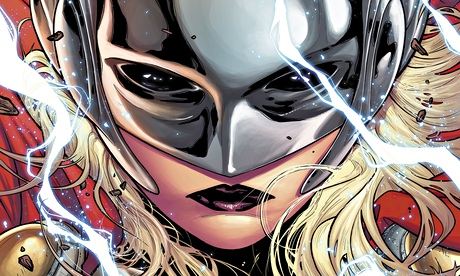
“This is not She-Thor. This is not Lady Thor. This is not Thorita. This is Thor.” This strong statement is how it was announced that the next wielder of Mjölnir will be female. The news has been met with zealous yet mixed reactions. Amid the witty responses that emphasise the inherent dynamism of comics, there are some who seem to feel that there could be nothing worse than a female Thor. The Marvel editor, Ryan Penagos, summed it up when he tweeted:
Was just called a gay slur and told to get cancer because of the Thor news. Go Internet!
— Ryan Penagos (@AgentM) July 15, 2014
If the boom in the comics industry in the last few years tells us nothing else, it demonstrates an enduring connection between our own hopes and dreams and the stories that we tell. The proliferation of superhero movies, the increasing popularity of Comic Con fan conventions, and wider awareness of the comics genre shows that we connect with these narratives in meaningful ways. In this sense, the problems or tensions that are traceable within the comics industry can tell us a lot about the issues we face in our daily lives.
The burgeoning Thor controversy is part of a network of problems to do with representation in comics, but one aspect in particular weighs heaviest in this context. We, as a western culture, still struggle with androcentrism – the belief that male experience is the norm and that everything else is, at best, a derivation of the norm and, at worst, abnormal. The negative reactions to Thor indicate discontent with a change in the status quo; it is a violation of what some fans consider to be “true”, to be “normal”. However, it’s not just change that is being rejected, but the possibility that the (male) norm is being revised. Yes, Thor has undergone previous changes – he was even a frog, but a male frog. In this way, maleness is continually seen as the centre of Thor’s universe, as the norm, and femaleness as an aberration.
The funny thing about norms is that they are subject to change. A norm is a standard, or a pattern, and so naturally as the field of observation changes so too will the resulting norm. Of course, it is also important to realise that norms aren’t “organic”, people make them. If I want to observe the normative mode of transportation in London, but disregard cyclists and pedestrians (for personal reasons I believe to be of no consequence), my definition of the norm will be very particular.
I took my indie feminist publication to London Film and Comic Con last weekend, and far from what one might expect I sold out of zines. I wasn’t just handing them to “feminist killjoys”, I was selling to women and men, young and adult. The truth is that the comics industry has always involved women, even if they weren’t a majority. Now, some of the most exciting names in the industry belong to female creators. Changes like the one being made to Thor are not about creating new exclusionary measures that erase older models; rather they are about broadening our field of observation. Geek culture is made up of, and enjoyed by, all kinds of people and our norms should reflect that. The standard for Thor will now include man, horse, frog and woman, because it should – because comics are for everyone.

